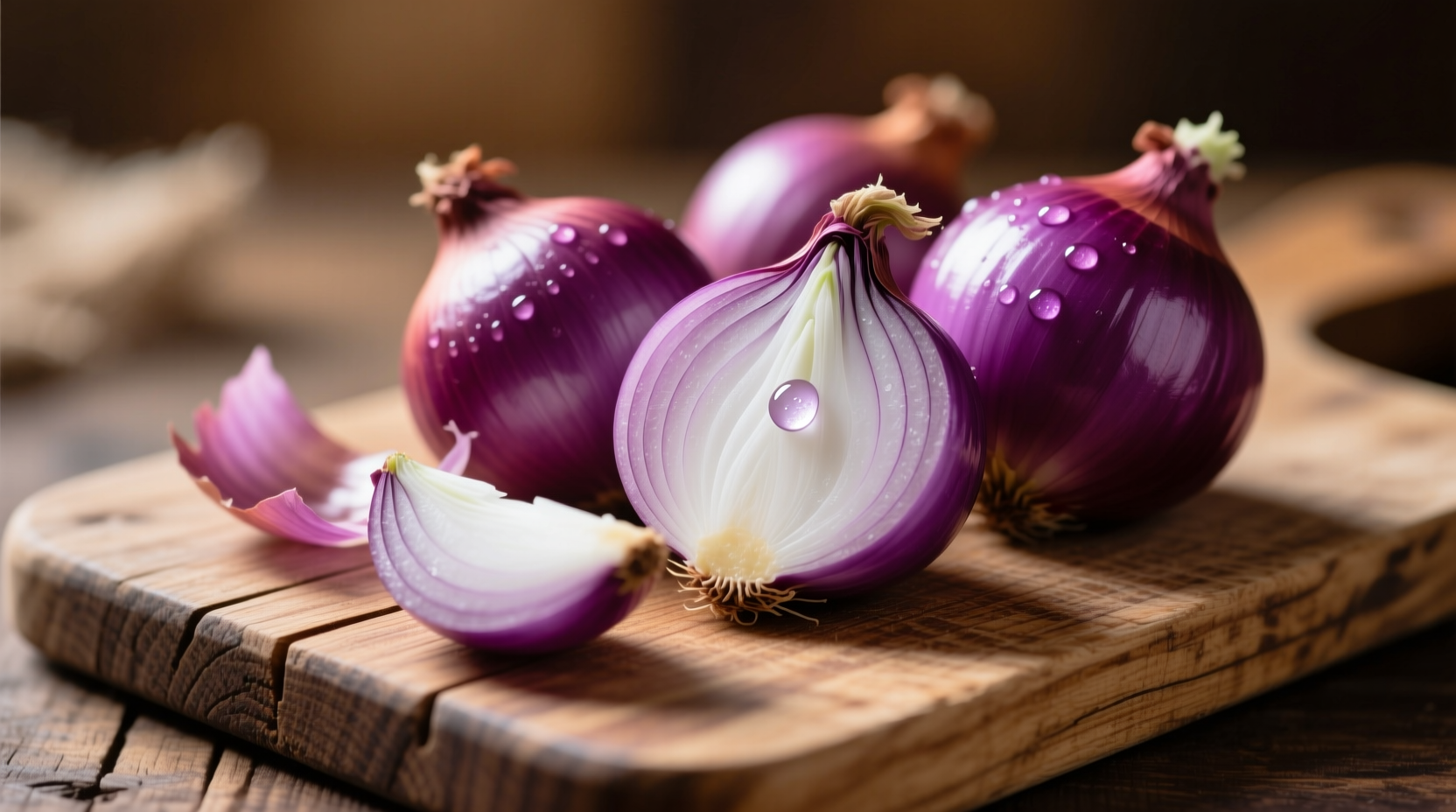When you search for "tim onion," you're likely looking for information about the small, clustered onions with purple skin commonly used across Asian cooking traditions. The term "tim" comes from Vietnamese ('hành tím'), where it specifically refers to shallots. Understanding this ingredient's unique properties can transform your cooking, whether you're preparing traditional Southeast Asian dishes or experimenting with global flavors.
What Exactly Is a Tim Onion?
Tim onions aren't a separate species but rather the Vietnamese name for shallots (Allium ascalonicum). These bulbous vegetables grow in clusters rather than as single bulbs like regular onions. Each cluster typically contains 3-6 individual cloves enclosed in a coppery-brown or purple-tinged skin. When sliced open, their flesh ranges from white to pale pink.
Unlike common misconceptions, tim onions aren't simply "small onions"—they have a distinct biochemical composition that creates their signature sweet, mild flavor with subtle garlic notes. This unique profile makes them indispensable in many culinary traditions where regular onions would overpower delicate dishes.
Historical Journey: From Ancient Fields to Modern Kitchens
Shallots have traveled a remarkable path through culinary history. Archaeological evidence suggests they were cultivated in Central Asia over 5,000 years ago. Ancient Egyptians valued them both as food and medicine, often including them in burial offerings. The Romans spread shallot cultivation throughout Europe, where they became particularly prized in French cuisine.
3000 BCE: Earliest evidence of shallot cultivation in Central Asia
1500 BCE: Shallots appear in Egyptian hieroglyphs and burial sites
1st Century CE: Romans introduce shallots to Western Europe
16th Century: French chefs begin incorporating shallots into classic sauces
Modern Era: Global trade makes shallots accessible worldwide, with Southeast Asia becoming a major producer
Tim Onion vs. Regular Onion: Key Differences
Understanding the distinctions between tim onions (shallots) and regular onions is crucial for proper culinary application. These differences affect flavor profiles, cooking behavior, and appropriate usage scenarios.
| Characteristic | Tim Onion (Shallot) | Regular Onion |
|---|---|---|
| Flavor Profile | Sweet, delicate with subtle garlic notes | Stronger, more pungent, sharper |
| Physical Structure | Grows in clusters of cloves | Single bulb structure |
| Chemical Composition | Higher sugar content, different sulfur compounds | More aggressive sulfur compounds |
| Culinary Best Uses | Vinaigrettes, delicate sauces, raw applications | Hearty stews, roasting, caramelizing |
| Storage Life | 2-3 months in cool, dry place | 1-2 months depending on variety |
Practical Culinary Applications
Tim onions shine in applications where their delicate flavor can enhance rather than dominate. Professional chefs consistently reach for shallots when creating:
- Vinaigrettes and dressings: Their mild flavor blends perfectly with acids without overwhelming
- Delicate sauces: French chefs prefer shallots for beurre blanc and other emulsified sauces
- Raw applications: Thinly sliced shallots add complexity to salads and garnishes
- Asian stir-fries: Essential base ingredient in many Vietnamese, Thai, and Indonesian dishes
When substituting in recipes, remember that 1 medium shallot equals approximately ½ cup finely chopped. For raw applications where sharpness matters, use a 2:1 ratio (two parts shallot to one part regular onion).

Nutritional Profile and Health Benefits
According to USDA FoodData Central, shallots offer impressive nutritional advantages over regular onions. Per 100g serving, they contain:
- 40% more antioxidants than yellow onions
- Higher concentrations of quercetin, a powerful flavonoid
- Rich in allicin compounds with documented cardiovascular benefits
- Lower water content, concentrating flavor and nutrients
Research published in the Journal of Agricultural and Food Chemistry confirms that shallots' unique sulfur compounds provide anti-inflammatory benefits while supporting healthy blood sugar regulation. These properties make them particularly valuable in balanced dietary approaches.
Selecting and Storing Tim Onions Properly
Choosing quality shallots significantly impacts your cooking results. Look for:
- Firm bulbs without soft spots or sprouting
- Intact, papery skin without tears or moisture
- Heavier bulbs for their size (indicates higher moisture content)
- Vibrant purple hues in the skin (for 'hành tím' varieties)
Proper storage extends shelf life significantly. Keep shallots in a cool, dark, well-ventilated space—never refrigerate whole shallots as moisture accelerates spoilage. Once cut, store in an airtight container in the refrigerator for up to 5 days. For long-term storage, freeze minced shallots in ice cube trays covered with oil.
When Tim Onions Aren't Available: Smart Substitutions
Ran out of shallots? Consider these substitution strategies based on your recipe's requirements:
- For raw applications: Use sweet onions like Vidalia with a squeeze of lemon to mimic shallot's delicate profile
- For cooking: Combine yellow onion with a pinch of garlic powder (use ⅔ yellow onion to ⅓ garlic powder)
- Premium alternative: Use pearl onions for similar texture in braised dishes
- Asian recipes: Substitute with young green onions for finishing touches
Remember that no substitution perfectly replicates shallots' unique flavor chemistry, but these alternatives maintain dish integrity when tim onions aren't available.
Common Questions About Tim Onions
Many home cooks have specific questions about incorporating tim onions into their cooking routine. Here are practical answers to frequent inquiries:
Can I substitute tim onions for regular onions in all recipes?
While possible, substitution isn't always ideal. Tim onions work best in delicate dishes like vinaigrettes, sauces, and raw applications where their mild flavor shines. For heartier dishes like stews or roasted vegetables, regular onions provide better structural integrity and stronger flavor that holds up to long cooking times.
Why do professional chefs prefer tim onions for sauces?
Tim onions (shallots) contain different sulfur compounds than regular onions, creating a more complex, less aggressive flavor when cooked down. Their higher sugar content helps sauces caramelize beautifully without bitterness, and they break down more completely, creating smoother emulsions in sauces like beurre blanc or demi-glace.
How can I reduce the strong taste of raw tim onions?
To mellow raw tim onions, try one of these professional techniques: soak sliced shallots in ice water for 10 minutes, toss with a pinch of sugar, or briefly blanch in boiling water. For salads, dressing acid (like vinegar or citrus) naturally tames their sharpness as it sits.
Are red onions the same as tim onions?
No, red onions and tim onions (shallots) are different. Red onions are a single-bulb variety with purple rings, while tim onions grow in clusters with more elongated cloves. Tim onions have a distinctly sweeter, more complex flavor profile with subtle garlic notes that red onions lack. In Vietnamese cooking, 'hành tím' specifically refers to shallots, not red onions.
What makes tim onions purple?
The purple color in tim onions comes from anthocyanins, natural pigments also found in blueberries and red cabbage. These compounds provide antioxidant benefits and can change color based on pH levels—turning more blue in alkaline environments and brighter red in acidic conditions. This property makes them useful natural food colorants in some culinary applications.











 浙公网安备
33010002000092号
浙公网安备
33010002000092号 浙B2-20120091-4
浙B2-20120091-4